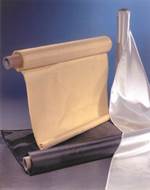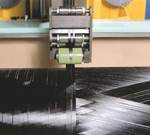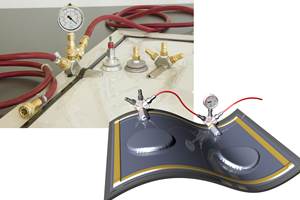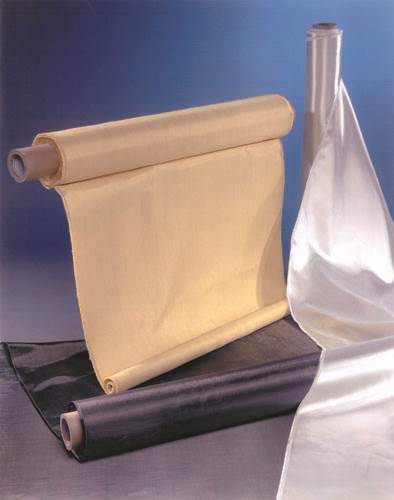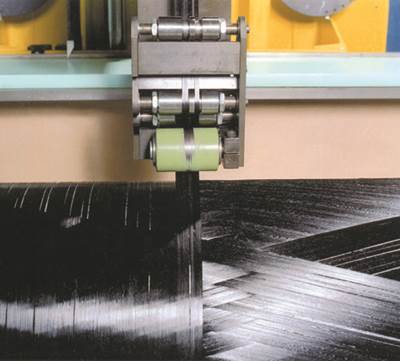Manufacturing Methods
Composite parts can be made in a controlled factory environment and delivered to the site as finished pipe, beams or grating, or fiber and resin can be combined on site to make or repair structures. Regardless of the fabrication method and its location, a quality composite requires that the reinforcement be co
Composite parts can be made in a controlled factory environment and delivered to the site as finished pipe, beams or grating, or fiber and resin can be combined on site to make or repair structures. Regardless of the fabrication method and its location, a quality composite requires that the reinforcement be completely saturated ("wet out") with resin. The composite must also be compacted to eliminate air bubbles and excess resin and must be fully cured prior to carrying loads in service.
While numerous manufacturing methods are used to produce composite components, three basic automated processes are used to manufacture structural components for offshore oil applications: pultrusion, filament winding and molding. Each process produces consistently high quality, dimensionally stable structures within stringent tolerances.
Pultrusion is a continuous process used to make profiles, tubular or solid shapes such as grating, pipe, beams or rod. A continuous process, it is cost-effective for high-volume production of constant cross-section parts. Pultrusion relies on reciprocating or caterpillar-type puller/clamping systems to pull fiber wet out with resin through a heated die. Roving and/or tow is pulled from material racks or creels and is saturated with resin, either via bath or injection. Excess resin is squeezed out by shaped bushings in a preformer positioned before the die. The compacted assembly enters the heated die, where the profile achieves its final shape and cures. As the cured part exits the die, it is cut to the appropriate length with a cutoff saw synchronized to the puller. Components may be designed to have off-axis strength, by folding mat or stitched fabrics into the material assembly before it enters the die. Surfacing veil fabricated into pultruded components, provides a resin-rich exterior finish.
Robust hydraulically driven systems capable of pulling several hundred thousand lbs through a forming die are now in operation, which can make structural profiles up to 3 ft/1m in depth. Hollow or complex profiles are pultruded with dies that incorporate heated mandrels to form the interior shape.
Filament winding is an automated, high-volume process for manufacturing pipe, tanks, tubing, pressure vessels and other cylindrical shapes. Machine setups can vary from basic 2-axis mechanical chain-drive operation to computer-controlled, multiaxis and multispindle systems capable of producing multiple lines of product at once. A wet winding machine pulls dry roving or tow from creels or racks through a resin bath. As the mandrel on the spindle rotates, the roving/tow delivery system, called the feedeye, reciprocates along the length of the mandrel, laying down a layer, or ply, of material. The speed of reciprocation and rotation are synchronized to hold a preset winding angle, ranging from 7° to 90°. Winding is also performed using prepreg tow (tow preimpregnated with resin), which eliminates the resin bath. Prepreg tow or tape made with carbon fiber and thermoplastic resin, such as that produced by manufacturer Sulzer Composites (Winterthur, Switzerland), is one option for producing high-performance filament wound composite spoolable pipe, especially for use as choke and kill lines in challenging offshore conditions.
A number of molding processes are available for producing composite parts, including compression molding, resin transfer molding (RTM), vacuum assisted resin transfer molding (VARTM) and centrifugal casting. Each uses molds to shape the reinforcement while resin is added. Heat and pressure (or vacuum) then compact the resin-impregnated fibers as the resin cures. Molding processes vary in the type of mold that is used, the method of introducing the resin and the amount of pressure or vacuum. For high-volume structural components, such as grating, closed molds are most common.
Related Content
GKN Aerospace, Joby Aviation sign aerostructures agreement
GKN Aerospace will manufacture thermoplastic composite flight control surfaces for Joby’s all-electric, four-passenger, composites-intensive ride-sharing aircraft.
Read MoreCOMPINNOV TP2 project promotes use of thermoplastics in aerospace
Completed in 2023, COMPINNOV TP2 explored thermoplastic composites, enhancing the understanding between prepregs and production methods to foster the potential for French aerospace innovation.
Read MoreSmartValves offer improvements over traditional vacuum bag ports
Developed to resolve tilting and close-off issues, SmartValves eliminate cutting through vacuum bags while offering reduced process time and maintenance.
Read MoreComposite resins price change report
CW’s running summary of resin price change announcements from major material suppliers that serve the composites manufacturing industry.
Read MoreRead Next
Composite Components: The String And The Glue
Fibers — whether glass, carbon or more esoteric varieties like aramid — are the backbone of composites. A single glass filament, thinner than a human hair, has a tensile strength of approximately 500 ksi/3.5 GPa, but essentially no compressive strength. To achieve a structural building material, fibers are enc
Read MoreResins
Resins fall into two broad categories: thermoset and thermoplastic. While both resin types consist of molecular polymer chains, thermosets crosslink during the cure reaction (initiated by heat, catalysts or both) and “set” into a final rigid form. Thermoplastic molecular chains are processed at higher temperat
Read MoreAll-recycled, needle-punched nonwoven CFRP slashes carbon footprint of Formula 2 seat
Dallara and Tenowo collaborate to produce a race-ready Formula 2 seat using recycled carbon fiber, reducing CO2 emissions by 97.5% compared to virgin materials.
Read More
